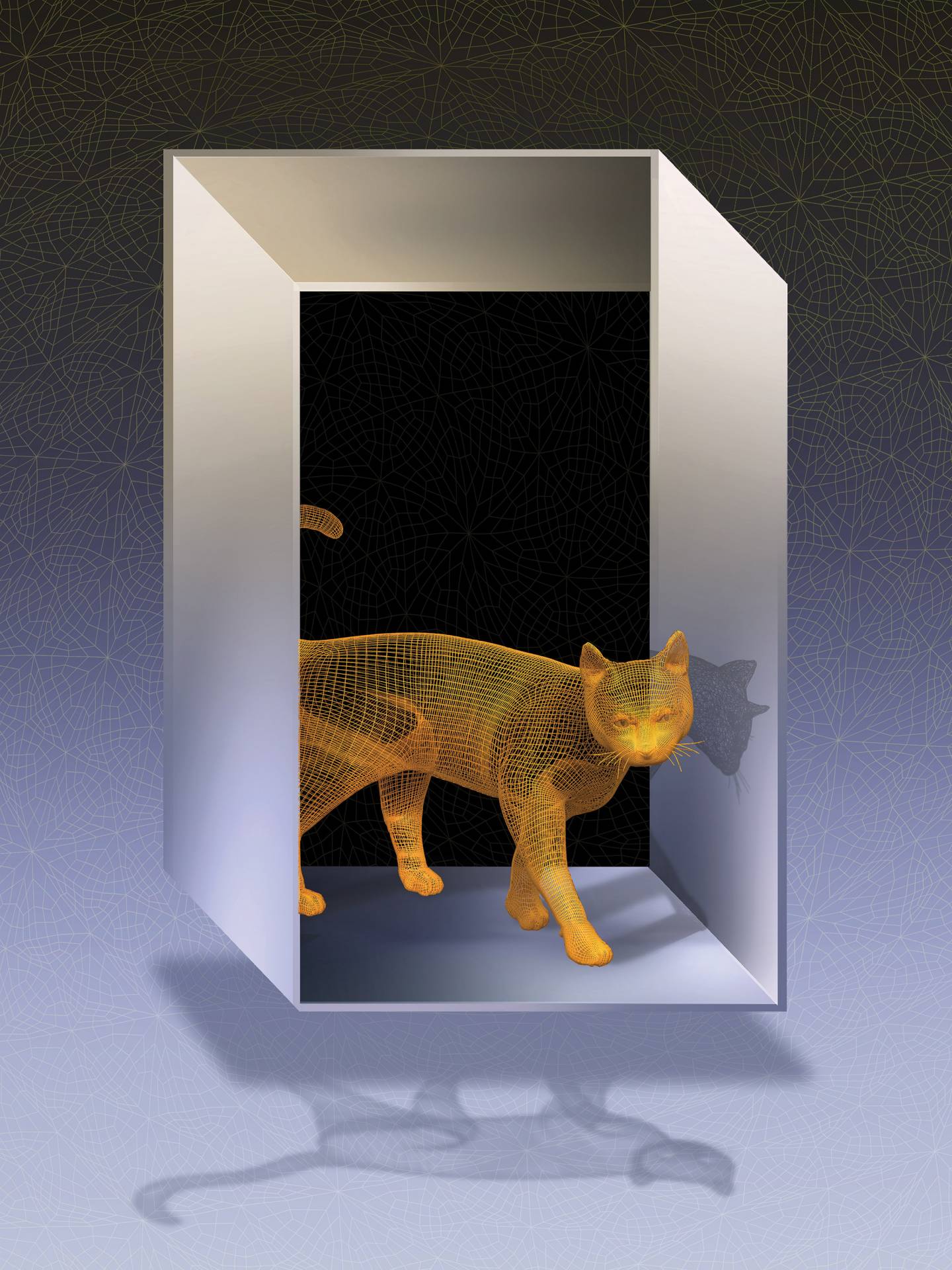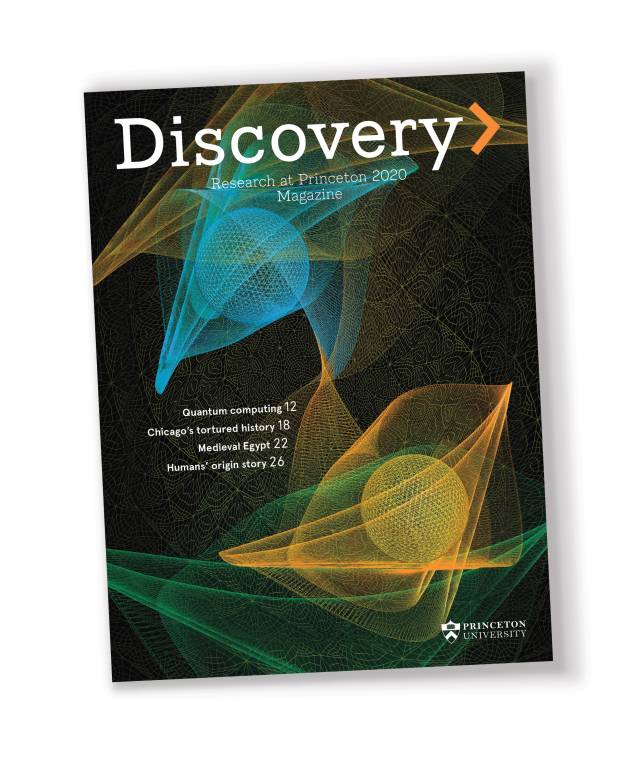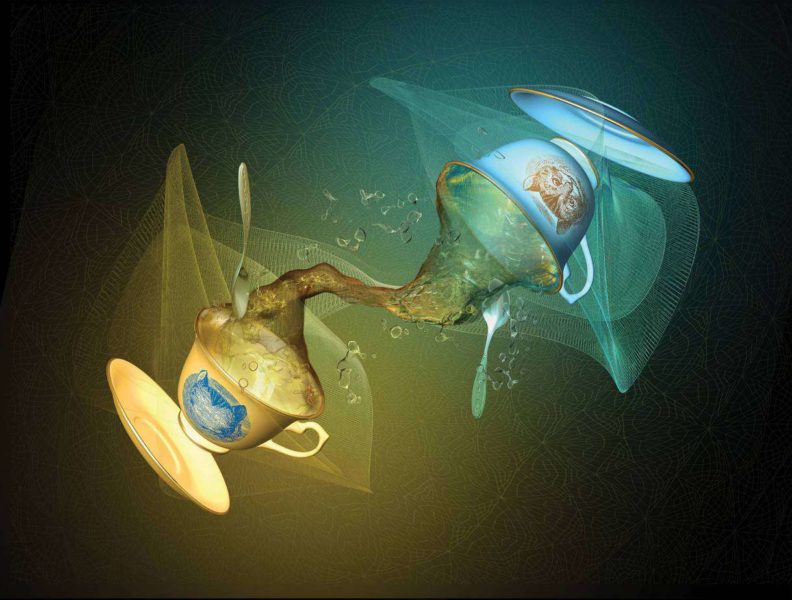Hidden beneath our everyday world — on the infinitesimal scale of atomic and subatomic particles — is a strange and elusive realm. It is a Lewis Carroll-like place where ghostly particles pop in and out of existence, swirling electrons occupy two positions at once, and objects possess dual natures — they can be both waves and particles simultaneously.
Despite the seeming irrationality of these concepts, scientists over the last 120 years have demonstrated that this realm — known as quantum mechanics — is the foundation on which our physical existence is built. It is one of the most successful theories in modern science. Without it, we would not have such marvels as atomic clocks, computers, lasers, LEDs, global positioning systems and magnetic resonance imaging, among many other innovations.
It is in the domain of information technology, however, that we might end up owing quantum mechanics our greatest debt. Researchers hope to use quantum principles to create an ultra-powerful computer that would solve problems that conventional computers cannot — from improving cybersecurity and modeling chemical reactions to formulating new drugs and making supply chains more efficient. This goal could revolutionize certain aspects of computing and open up a new world of technological possibilities.
Thanks to advances at universities and industry research centers, a handful of companies have now rolled out prototype quantum computers, but the field is still wide open on fundamental questions about the hardware, software and connections necessary for quantum technologies to fulfill their potential. Researchers at Princeton are working to chart the future of quantum computing through foundational research in their labs and through collaborations with industry partners.
“What’s exciting about Princeton is that we have real expertise in both the fundamental science and the engineering,” said Andrew Houck, professor of electrical engineering. “We have world leaders at every layer of this research.”
The fundamental component of this new technology is the qubit, a quantum version of the classical bit that everyday computers use to represent information. A classical bit has a value of either 0 or 1, and joining these bits into strings enables computers to represent information such as letters and numbers.
Quantum bits, by contrast, can have a value of 0 or 1 at the same time. This bizarre quality stems from a quantum concept called superposition, in which an object can exist in two or more states at once. The concept, were it to be applied to everyday life, would result in the paradox known as Schrödinger’s cat, in which a fictional cat is simultaneously alive and dead.
Quantum computers take advantage of the ability for qubits to exist in different states at the same time. This means that quantum computers can consider a lot more information at once, evaluating many outcomes simultaneously, thereby increasing their calculating power exponentially. Read a primer on the vocabulary of qubits and related terminology.
Introducing the Princeton Quantum Initiative
In September 2019, the University announced the creation of the Princeton Quantum Initiative to foster exploration and education across the spectrum from fundamental quantum research to applications in areas such as computing, sensors and communications.
The initiative comes at a time of national momentum for quantum sciences. In 2018, the federal government established the National Quantum Initiative to energize research and training in quantum information science and technology. The Princeton initiative will offer fellowships for graduate students and postdoctoral researchers, and research and educational opportunities for undergraduates.
Over 30 faculty members, drawn from the departments of electrical engineering, physics, chemistry, computer science, and mechanical and aerospace engineering, will participate in the new program. The initiative will enable new research collaborations across campus and with other universities and industry.
The initiative’s inaugural director is Andrew Houck, professor of electrical engineering. “We have an incredible collection of experts in their respective disciplines,” Houck said, “and the Princeton Quantum Initiative gives us an entity that brings everyone together to accelerate the pace of discovery.”
The quest for qubits
Over the last three decades, quantum researchers have come up with a handful of ways to make qubits. The heart of a qubit is typically a very small particle — such as an atom, ion or electron — that due to its tiny size exhibits quantum properties.
One of these is the superconducting qubit or transmon, which is already in use in some early-stage commercial quantum computer prototypes from IBM and Google. A transmon is a sort of artificial atom built from materials such as niobium and aluminum that, at low temperatures, can carry electrical current without resistance. These materials are patterned to form a small electrical circuit that behaves like an atom. The state of the qubit, the quantum 0 or 1, is represented by the amount of energy stored in the artificial atom.
Maintaining this quantum state long enough to be useful, however, is one of the major challenges for the transmon and other types of qubits. Environmental influences such as vibrations, heat or light can disrupt quantum properties. This “decoherence” can make it difficult to maintain a particle in a quantum state for even a brief length of time.
“Quantum states are incredibly fragile,” Houck said. “Real progress is keeping these quantum mechanical properties ‘alive’ for as long as possible so that you can do the kinds of computations, sensing or communications that you want to do before all this falls apart.”
To address this challenge, Houck and his team are collaborating with IBM Research to fortify the transmon by building more complex circuits that guard against decoherence. This will allow the transmon to hold a quantum state for several hundred microseconds, which is long enough to carry out many computing steps and represents a huge leap from previous qubit technology.
Another strategy for making qubits involves real atoms. Jeffrey Thompson, assistant professor of electrical engineering, cools atoms down to incredibly low temperatures and traps them in a vacuum chamber. Once isolated, the researchers can manipulate an individual atom with tightly focused laser beams called optical tweezers. The researchers can then use additional laser signals to set the trapped atom’s energy levels to represent quantum 0 or 1 states.
“Atoms make very good qubits,” Thompson said. “They are actually easy to work with, and it’s very easy to see a single atom using laser light.”
Still another type of qubit relies on electrons, or more specifically, an inherent quantum property of electrons known as spin. Spin describes the electron’s angular momentum and is sometimes likened to the twirling movement of a top, but it is also analogous to magnetism because, like a magnet, an electron’s spin can point either downward or upward, representing the values of 0 and 1.
Stephen Lyon, professor of electrical engineering, is one of the researchers exploring ways to keep spin qubits in superposition for relatively long periods. His team sends microwave pulses through a highly purified type of silicon, called silicon-28, to coordinate the spins of millions of electrons. The researchers have shown that they can keep spin qubits in superposition for up to 10 seconds, a lengthy duration in the quantum realm.
For quantum computing to achieve its full potential, qubits will not only need to keep their quantum states, but they will also need to share information with each other. They do this via a quantum property called entanglement.

Like superposition, entanglement is a baffling — but fundamental — quantum concept. It describes how two particles can act in concert. After two or more quantum particles interact, they can retain their connection or interdependence. If one qubit acts in a certain way, its entangled twin will act in the same way, no matter the distance that divides them. They can be millions of miles away but still act in perfect unison. This counterintuitive notion, which has survived numerous challenges since its discovery in the 1930s, led Albert Einstein to label entanglement as “spooky action at a distance.”
By entangling qubits, researchers can build quantum circuits that can do complex calculations. Jason Petta, the Eugene Higgins Professor of Physics, is working on this challenge for silicon-based spin qubits. Single spins can have a lifetime of up to one minute. Silicon spin qubits could prove less expensive and easier to manufacture than other types of qubits, and although they are not as far along in development as transmons, they are quickly catching up due to recent advances.
Petta’s team is devising ways to transfer the information coded in the electron’s spin from one qubit to another — getting electrons to, as he calls it, “talk to each other.” They build qubits by confining electrons in tiny silicon chambers called quantum dots. The researchers can then apply a strong magnetic field to the dots to coax them to transfer their quantum information to particles of light, or photons, which act as messengers to carry the information to other quantum dots located nearby. This strategy has already been used to entangle superconducting qubits, and the Petta group showed that this approach also works for spin-based qubits.
“It’s like putting an electron and a photon in the same room,” Petta said. “You can transfer some of the spin properties to the photon, which is flying around the room, and then use the photon to transmit information to another spin on the opposite side of the room.”
The variety of ways of producing qubits underscores the state of quantum computing today. One of the more long-term strategies is to make qubits from Majorana fermions, which are particle-like objects that form under specific conditions. Predicted nearly a century ago, these quasi-particles were recently observed in experiments led by Ali Yazdani, the Class of 1909 Professor of Physics. The properties of these quasi-particles stem from a branch of mathematics called topology, which describes how objects can be bent or stretched without losing their inherent properties. This property could give these topological qubits better protection from decoherence.
Which qubit will ultimately form the basis of a future quantum computing industry? This is a quickly developing field with everyone hesitant to predict which qubit will prove the best, according to Lyon. “There are all these different technologies,” he said, “and the simple matter is we don’t know which one is going to work best.”
The quantum internet
Creating well-functioning qubits is only one aspect of quantum computing. An equally important goal is the creation of a quantum information network — a quantum internet — that will be more secure than today’s internet. Nathalie de Leon, assistant professor of electrical engineering, is testing the viability of synthetic diamonds as devices that store and transmit information from one place to the next. Although a diamond may look clear and flawless, a close examination reveals something very different.
“If you take a diamond and pull it out of the ground and look at it, you’ll notice all these little defects,” de Leon said. These defects give diamonds their color, but it turns out that they also can store and transmit information.
De Leon and her colleagues figured out that by replacing two carbon atoms with a silicon atom, this particular flaw in diamonds can act as a perfect receptacle to catch a photon. Photons already carry information via the optical fibers of today’s internet, and they can also be used to carry quantum information.
De Leon and her team are working to transmit quantum information from photons to electron spins, where further fine-tuning can prolong the quantum state by keeping electron spins in the proper orientation.
Quantum entanglement ensures that this new kind of internet is secure against hackers. Any attempt to eavesdrop on the transmission will perturb its state. By comparing the transmitted photon to its entangled twin, the receiver can tell if an eavesdropper has disrupted the transmission. “As long as the laws of physics are correct, our channel is secure,” de Leon said.
Quantum architecture
A handful of quantum computers are now in operation, and a few are available for experimentation through the cloud, but they are still works in progress. For one thing, these computers have qubits in the hundreds, whereas several thousands or even millions of qubits are needed for hard problems. Another challenge is that qubits are difficult to manufacture, and some of the qubits won’t behave as expected, requiring researchers to add extra qubits for quantum error correction.
And although quantum computers will be capable of addressing problems that we currently have no way of solving, they likely will not replace our familiar computers for everyday tasks. “We’re not going to have a quantum computer in my laptop or phone,” said Margaret Martonosi, the Hugh Trumbull Adams ’35 Professor of Computer Science. “It’s a fairly unique and narrow set of algorithms where quantum computers have an advantage over classical computers.”
One of the unique and narrow algorithms, however, could crack the encryption codes in use today to protect credit card transactions on the internet. The potential misuse of quantum power is driving the search for new quantum cryptography methods.
Martonosi is one of the pioneers thinking about how quantum computers will make the transition from laboratory prototypes into practical, functioning devices. This area of research is called computer architecture, and involves everything from how a quantum computer would interface with existing technologies to what types of software would be compatible with quantum systems.
In today’s computers, software plays the role of coordinating and translating bits into calculations and results. The same applies to quantum computing. Martonosi and her team are developing programs called compilers that read and translate high-level programming languages down to the level of the computer’s qubits.

“Our compiler uses advanced optimization techniques to exploit the better-behaving qubits,” she said.
She is also developing software to explore which algorithms work best with different kinds of qubits, and is optimistic about recent developments in the field. “Every new qubit in a quantum computer, if it behaved in an ideal way, would actually double the capability of a quantum computer,” Martonosi said. “This would be faster and better than the largest supercomputer on Earth. That will be an important milestone.”
Although truly powerful quantum computers with millions of qubits are still years away, the technologies for creating this advantage are edging closer. Our knowledge has progressed to the point where rather than simply studying quantum mechanics, we are on the verge of unlocking vast new capabilities utilizing its bizarre, ghostly concepts.
Qubit zoo: Quantum vocabulary and terminology
Following is a brief primer of quantum computing concepts and terms.
Qubits not bits. Quantum computers do calculations with quantum bits, or qubits, rather than the digital bits in traditional computers. Qubits allow quantum computers to consider previously unimaginable amounts of information.
Superposition. Quantum objects can be in more than one state at the same time, a situation depicted by Schrödinger’s cat, a fictional feline that is simultaneously alive and dead. For example, a qubit can represent the values 0 and 1 simultaneously, whereas classical bits can only be either a 0 or a 1.
Entanglement. When qubits are entangled, they form a connection to each other that survives no matter the distance between them. A change to one qubit will alter its entangled twin, a finding that baffled even Einstein, who called entanglement “spooky action at a distance.”
Types of qubits. At the core of the quantum computer is the qubit, a quantum bit of information typically made from a particle so small that it exhibits quantum properties rather than obeying the classical laws of physics that govern our everyday lives. A number of types of qubits are in development:
- Superconducting qubits, or transmons. Already in use in prototype computers made by Google, IBM and others, these qubits are made from superconducting electrical circuits.
- Trapped atoms. Atoms trapped in place by lasers can behave as qubits. Trapped ions (charged atoms) can also act as qubits.
- Silicon spin qubits. An up-and-coming technology involves trapping electrons in silicon chambers to manipulate a quantum property known as spin.
- Topological qubits. Still quite early in development, quasi-particles called Majorana fermions, which exist in certain materials, have the potential for use as qubits.


